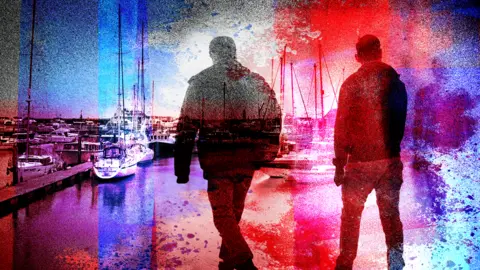In the contemporary landscape of immigration and border security, the growing concern surrounding people smuggling has gained heightened media attention. A recent article features a compelling narrative from a former British soldier turned people smuggler, known as Nick, who provided insights into how he facilitated the transport of Vietnamese migrants into the UK via yachts. This admission sheds light on the vulnerabilities of the UK’s coastal security measures and emphasizes the ease with which such criminal activities can persist.
Nick’s account begins by illustrating his earlier life as a soldier and, later, a builder who found himself in dire financial straits during the economic downturn of the late 2000s. In his pursuit for survival and financial stability, he was drawn into the world of human trafficking, under the guidance of associates like an Albanian named Matt, who introduced him to the smuggling trade. Their arrangement involved Nick being paid handsomely to transport individuals, which escalated in complexity as he began to utilize yachts to land migrants discreetly in the charming locales ranging from Ramsgate to other private marinas in Southeast England.
One of the key revelations from Nick’s confessions is the surprising lack of security in private marinas, a point echoed by harbor officials who likened the security there to that found in caravan parks. As Nick revealed, the absence of constant surveillance at these maritime facilities allows individuals like him to operate with relative impunity. Nick’s exploits underline a systemic issue that has drawn the scrutiny of UK authorities. Charlie Eastaugh, the director of maritime at Border Force, articulated this concern, highlighting that despite the best efforts of agencies responsible for coastal security, private operators are left to manage their own defenses with little oversight.
Nick’s smuggling operations were facilitated by careful planning around tides and weather, enabling him to set sail under the cover of darkness. He detailed how he would pick up migrants from various discreet locations in France, often returning to the UK and hiding them in concealed areas on the boat until they could be transported further inland. His methods, which included utilizing lorries to transport migrants across the Channel, demonstrate the lengths to which smugglers will go to evade detection by law enforcement authorities. These dangerous tactics have deteriorated the already precarious state of immigration enforcement in the region.
Crucially, Nick’s narrative draws a stark contrast with the more publicized cases of migrants crossing the English Channel in small boats. The vast majority of those crossing are seeking asylum and often seek to be rescued by authorities. In contrast, many of the Vietnamese migrants Nick smuggled preferred anonymity, aiming to disappear into the illegal labor market rather than enter the official immigration system.
Border Force’s resources, focusing predominantly on responding to small craft crossings have produced an alarming oversight regarding potential threats in the maritime domain. Former Border Force chief Tony Smith acknowledged that while resources are tactically deployed to deal with immediate threats, a more substantial presence in less trafficked areas might be crucial for identifying and dismantling people smuggling networks.
In summary, Nick’s journey illustrates a painful paradox; while authorities strive to combat human trafficking and illegal immigration, vulnerabilities, particularly in private marinas, continue to be exploited by individuals involved in smuggling. His story serves as a wake-up call regarding the urgent need for enhanced security measures in maritime areas and highlights the complexities involved in managing immigration in the UK. As Nick voices concern that people may be unhappy with his revelations about ongoing smuggling routes, it becomes clear that discussions like these are pivotal in understanding and addressing the challenges of human trafficking and border security in an increasingly interconnected world.



